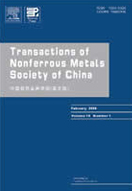Adsorption of copper using macroporous phosphonic acid resin
(1. College of Food Science, Biotechnology and Environmental Engineering,
Hangzhou University of Commerce, Hangzhou 310035, China;
2. Department of Chemistry, Lishui Teachers College, Lishui 323000, China)
Hangzhou University of Commerce, Hangzhou 310035, China;
2. Department of Chemistry, Lishui Teachers College, Lishui 323000, China)
Abstract: The adsorption behavior and mechanism of a novel chelate resin, macroporous phosphonic acid resin(PAR) for Cu(Ⅱ) were investigated. The statically saturated Cu(Ⅱ) adsorption capacity is 168mg/g resin at 298K in HAc-NaAc medium. The Cu(Ⅱ) adsorbed on PAR can be eluted by 1.0-3.0mol/L HCl and the elution percentage reaches 100%. The resin can be regenerated and reused without apparent decrease in adsorption capacity. The apparent adsorption rate constant is
k=1.64×10-4s-1 at 298K. The adsorption behavior of PAR for Cu(Ⅱ) obeys the Freundlich isotherm. The thermodynamic adsorption parameters, enthalpy change ΔH, free energy change Δ/G/ and entropy change ΔS of PAR for Cu(Ⅱ) are 11.8kJ/mol, -2.0kJ/mol and 46.4J·mol-1·K-1 respectively. The apparent activation energy is Ea=8.0kJ/mol. The molar coordination ratio of the functional group of PAR to Cu(Ⅱ) is about 2∶1. The adsorption mechanism of PAR for Cu(Ⅱ) was examined by chemical method and IR spectrometry.
k=1.64×10-4s-1 at 298K. The adsorption behavior of PAR for Cu(Ⅱ) obeys the Freundlich isotherm. The thermodynamic adsorption parameters, enthalpy change ΔH, free energy change Δ/G/ and entropy change ΔS of PAR for Cu(Ⅱ) are 11.8kJ/mol, -2.0kJ/mol and 46.4J·mol-1·K-1 respectively. The apparent activation energy is Ea=8.0kJ/mol. The molar coordination ratio of the functional group of PAR to Cu(Ⅱ) is about 2∶1. The adsorption mechanism of PAR for Cu(Ⅱ) was examined by chemical method and IR spectrometry.
Key words: macroporous phosphonic acid resin; copper; adsorption; mechanism

